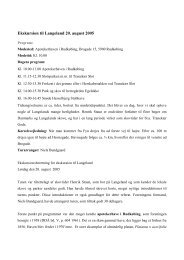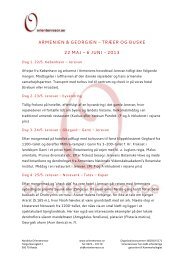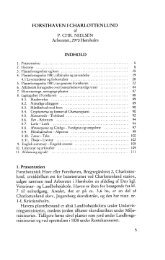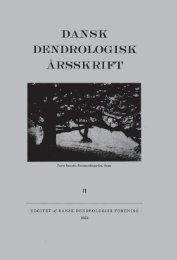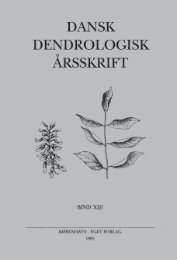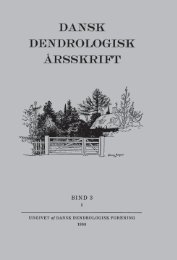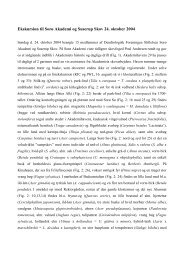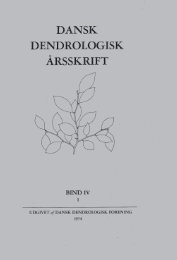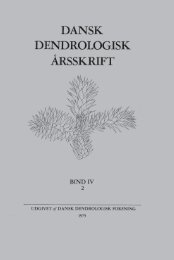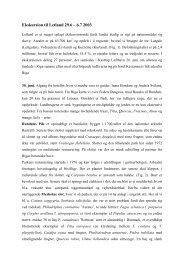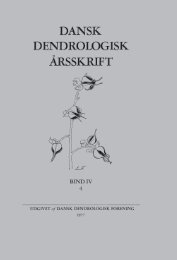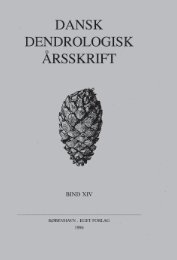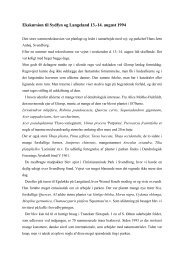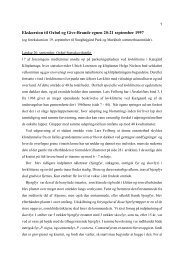Volume 2,1 (1963) - Dansk Dendrologisk Forening
Volume 2,1 (1963) - Dansk Dendrologisk Forening
Volume 2,1 (1963) - Dansk Dendrologisk Forening
Create successful ePaper yourself
Turn your PDF publications into a flip-book with our unique Google optimized e-Paper software.
and a and f quite intersterile. The question is, do a and f belong to<br />
the same species? I should like to answer yes, because they are connected<br />
by a series of intergrades but in some thousands of years they<br />
may be established as veritable and well defined species.<br />
Not seldom do we find morphologically as well as ecologically clearly<br />
distinct species that will produce hybrids of high fertility. So do f.i.<br />
several species of Salix, Larix and - to mention some herbacious<br />
plants too - Geum rivale L. and G. urbartum L. We sometimes find<br />
the Geu/rz-hybrid in nature but mostly it will disappear in the course<br />
of a few years and distinguishable intermediate backcrosses are very,<br />
very seldom met with; the two species seem to the only important in<br />
nature presumably because of either selection due to competition,<br />
or a cytological tendency to reestablish the genoms of the parental<br />
species, or the want of suitable growing places for the hybrid. Among<br />
trees and shrubs f.i. Salix caprea L. and S. cinerea L. hybrids and<br />
backcrosses seem to be more common; this is probably partly due<br />
to their longevity and partly to their dioecious nature. Everybody<br />
having studied this complex in nature will know that by far the<br />
greater part easily may be referred either to S. caprea or to S. cinerea.<br />
Thus we may conclude, that in cases of intersterility we mostly<br />
have well defined species, and that interfertile species are to be considered<br />
as true species if they are clearly preferred as competitors on<br />
certain growing places in nature. Often, but not at all always this is a<br />
very useful way to distinguish true species but a thorough knowledge<br />
to the growing places of the forms in question is inevitable because<br />
in the herbariums the number of hybrids and intermediate<br />
forms will give quite a false concept of their importance in nature<br />
because of a tendency to collect specimens deviating from the main<br />
part of the bunch. If intergrades are frequent and of real importance<br />
in nature it must be an omen to consider whether it would not be<br />
better to amalgamate the two (or more) species into one.<br />
VI. Ignorance concerning the natural variation of a species due to<br />
the - from a biological point of view - misleading use of a typespecimen<br />
that may be a rare variety of a species or a cultigen type<br />
(f.i. in Aucuba japonica Thunb. and Cupressus sempervirens L. the<br />
types are a variegated and a fastigiate form respectively). This point<br />
is especially of importance to dendrology because - even when the<br />
type-specimen is a representative for the main part of the species -<br />
only one or at most a few are cultivated in a garden or an arboretum<br />
and either propagated by seeds, producing lots of hybrids, or vegetatively<br />
illustrating the invariability not of the species but of the type-



